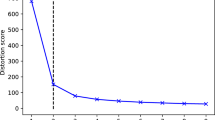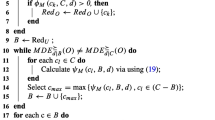Abstract
Mining effective data from wireless sensor network node data is one of the main subjects in studies concerning wireless sensor network data processing. Wireless sensor network data are muli-dimensional and dynamic. Generally, data mining technology cannot satisfy the requirements of wireless sensor network. A large amount of accumulated and redundant wireless sensor network monitoring data reduces the efficiency of data processing. To solve the above problems, this study proposed a data mining algorithm, which integrated rough set algorithm and genetic algorithm to mine redundant data in node network data. The results of the simulated calculation based on MATLAB platform suggested that the identification rate, false accept rate and reject rate of the proposed algorithm were 94.65, 1.753 and 2.331%; compared to network data mining algorithm based on improved genetic algorithm, it has higher efficiency and accuracy in data mining. The algorithm could effectively excavate redundant data in wireless sensor network and optimize the operation environment of wireless sensor network. The application of the rough set and genetic algorithm based data mining algorithm in wireless network has a promising prospect.
Similar content being viewed by others
References
Andrew, N. and Kemal, A., Distributed collaborative camera actuation for redundant data elimination in wireless multimedia sensor networks, Ad Hoc Networks, 2011, vol. 9, no. 4, pp. 514–527.
Benazir, F. and Manimaran, G., Energy minimization by exploiting data redundancy in real-time wireless sensor networks, Ad Hoc Networks, 2013, vol. 11, no. 6, pp. 1715–1731.
Song, D., Lechan, Y., Dong, Y., Xiong, F., and Zhuo, M., Distributed global function model finding for wireless sensor network data, Appl. Sci., 2016, vol. 6, no. 2, p. 37.
Jie, H., Wenqiang, L., and Ming, D., Block-type high temperature gas cooled reactor reloading pattern optimization using genetic algorithm, High Power Laser Part. Beams, 2017, no. 1, pp. 7–13.
Sanchez Ramirez, A., Kallol, D., Richard, L., Tinga, T., and Havinga, P., Wireless sensor network for helicopter rotor blade vibration monitoring: Requirements definition and technological aspects, Key Eng. Mater., 2013, vols. 569–570, pp. 775–782.
Shuqin, G., Hongyan, Y., Chen, L., Ligang, H., and Jinhui, W., A design of the node system of wireless sensor net for ancient building fire prevention, Electromagn. Compat., 2012, vol. 18, no. 1, pp. 241–244.
Ahmad, N., Riaz, N., and Hussain, M., Adhoc wireless sensor network architecture for disaster survivor detection, Int. J. Adv. Sci. Technol., 2011, vol. 34.
Erdogan, S.Z. and Bilgin, T.T., A data mining approach for fall detection by using k-nearest neighbour algorithm on wireless sensor network data, IET Commun., 2012, vol. 6, no. 18, pp. 3281–3287.
Ismail, B., Salvatore Domenic, M., and Ravi, S., A survey of intrusion detection systems in wireless sensor networks, IEEE Commun. Surv. Tutorials, 2014, vol. 16, no. 1, pp. 266–282.
Supakit, N. and Boontee, K., Technique for reducing the time required for local optimum searching in a hybrid genetic algorithm, J. Comput. Sci. Technol., 2011, vol. 5, no. 1, pp. 38–53.
Jerzy, B., Slowinski, R., and Marcin, S., Sequential covering rule induction algorithm for variable consistency rough set approaches, Inf. Sci., 2011, vol. 181, no. 5, pp. 987–1002.
Yu, Z., Baosheng, K., Hongan, L., and Fangling, S., Improved algorithm for point cloud data simplification, J. Comput. Appl., 2012, vol. 32, no. 2, pp. 521–523.
Fanyong, M. and Xiaohong, C., A new method for triangular fuzzy compare wise judgment matrix process based on consistency analysis, Int. J. Fuzzy Syst., 2017, vol. 19, no. 1, pp. 27–46.
Andrea, V. and Karel, L., MatConvNet: Convolutional neural networks for MATLAB, ACM International Conference on Multimedia, 2015, pp. 689–692.
Hui, W. and Cuiyu, Z., Differences between network data mining algorithm based on improved genetic algorithm, Comput. Simul., 2015, no. 5, pp. 311–314.
Author information
Authors and Affiliations
Corresponding author
Additional information
The article is published in the original.
About this article
Cite this article
Diao, H. Deep Mining of Redundant Data in Wireless Sensor Network Based on Genetic Algorithm. Aut. Control Comp. Sci. 52, 291–296 (2018). https://doi.org/10.3103/S0146411618040053
Received:
Accepted:
Published:
Issue Date:
DOI: https://doi.org/10.3103/S0146411618040053




